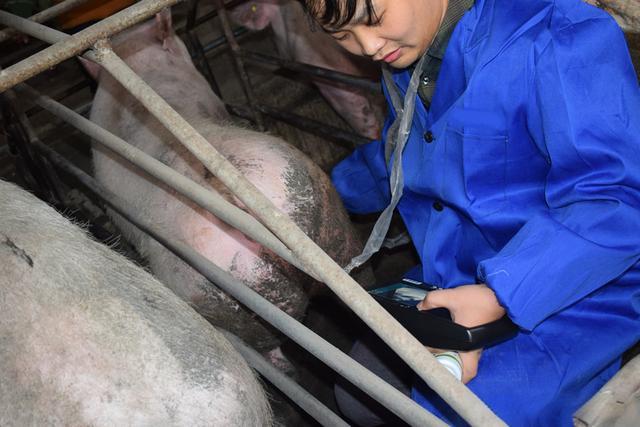In modern swine production systems, reproductive efficiency directly impacts farm profitability. One of the most common and economically damaging reproductive issues in sows is postpartum uterine infection, also known as metritis or endometritis. Traditionally, the diagnosis of such conditions has relied on clinical signs, vaginal discharge, or manual palpation, which often lack accuracy and are subjective. However, the adoption of portable ultrasound—a non-invasive, real-time imaging technique—has transformed how veterinarians and producers identify and manage uterine infections in swine. This article explores the diagnostic value of portable ultrasound in detecting uterine infections post-partum, with emphasis on practical field applications, international perspectives, and future directions.

Understanding Uterine Infections in Postpartum Sows
After parturition, a sow’s uterus undergoes involution and clearance of fetal membranes and fluids. However, due to retained placental tissue, dystocia, or poor hygiene, this process can be disrupted, allowing opportunistic bacteria to colonize the uterine lining. These infections may not be immediately apparent and can range from subclinical to severe, with signs such as:
Fever
Reduced appetite
Lethargy
Vaginal discharge with a foul odor
Decreased milk production
Impaired subsequent fertility
Early and accurate detection is vital. Delayed treatment often leads to long-term reproductive failure and economic losses.
Why Ultrasound? A Shift Toward Precision Diagnosis
In recent years, portable ultrasound has gained widespread popularity in swine veterinary practice, particularly in Europe, North America, and parts of Asia. It offers several distinct advantages over traditional diagnostic methods:
Non-invasive: No internal manipulation is required, reducing stress and discomfort.
Real-time imaging: Allows immediate visualization of uterine contents.
High sensitivity: Detects abnormalities like fluid accumulation, thickened endometrium, or retained fetal parts.
Repeatability: Can be used regularly without harm to the animal.
Unlike rectal palpation, which is impractical in swine due to their anatomy, ultrasound is applied transabdominally or transrectally using a small probe, making it suitable even for farms with limited resources.
What Does Uterine Infection Look Like on Ultrasound?
Veterinary ultrasonography identifies key signs of uterine pathology post-partum. With a B-mode (brightness-mode) scanner, such as those used in portable veterinary models, the veterinarian can observe:
Hypoechoic or anechoic fluid: Signifies pus or retained lochia in the uterine horns.
Echogenic debris: Indicates infection and inflammation.
Thickened uterine wall: Reflects chronic inflammation.
Gas inclusions: Suggest anaerobic bacterial infection.
Irregular uterine shape: Possibly due to fibrosis or chronic endometritis.
In well-managed swine herds, a normal postpartum uterus clears fluid within 5–7 days. Persistent fluid beyond this period warrants concern.
Portable Ultrasound in Practice: A Case from the U.S.
At a commercial swine operation in Iowa, veterinarians implemented routine postpartum ultrasound screening for sows exhibiting reduced feed intake or abnormal discharge. Using a waterproof, handheld scanner, they scanned over 200 sows within 10 days post-farrowing. Findings included:
15% had intrauterine fluid accumulation
6% had retained fetal tissues
9% exhibited uterine wall thickening
Based on these results, targeted antibiotic therapy was administered only to affected animals. Compared to blanket treatment protocols used previously, this method reduced drug use by over 40% while maintaining reproductive performance. The use of portable ultrasound helped improve both animal welfare and farm sustainability.

Global Perspectives on the Use of Ultrasound for Uterine Diagnosis
Europe: In countries like Denmark and the Netherlands, where antimicrobial use is heavily regulated, ultrasound is encouraged as a tool to justify selective treatment. Portable scanners have become common even in medium-scale farms.
North America: Leading veterinary schools and swine consultants emphasize the use of point-of-care ultrasound in herd health checks. Organizations like the American Association of Swine Veterinarians offer training in reproductive ultrasonography.
Asia: In regions with rapid pig farm industrialization, such as China and Vietnam, portable ultrasound is increasingly integrated into farrowing management to improve sow longevity and reduce culling rates.
Economic Value of Early Detection
From an economic standpoint, uterine infections post-partum are costly. A single missed infection can result in:
Extended weaning-to-estrus intervals
Decreased conception rates
Increased sow culling
A 2022 study in the Journal of Swine Health and Production estimated that early diagnosis of endometritis using ultrasound saved approximately $30 per sow by preventing fertility loss and unnecessary treatment. For a 500-sow herd, this translates to $15,000 in annual savings.
Advantages of Portable Ultrasound Models
Several portable veterinary ultrasound machines now cater to swine practitioners. Key features to look for include:
Waterproof, dustproof design
Long battery life (6+ hours)
Multiple probe compatibility (linear or convex)
High-resolution display
Lightweight and durable body
One model widely praised in the field is the BXL-V50, which offers:
HD screen for clear uterine images
One-button capture for easy training and usage
Ergonomic design for left or right-handed operators
Precise imaging even in high-fat sows
These features make it especially suitable for mobile veterinary use or integration into smart farming systems.

Future Directions: Integrating AI and Data Analytics
As swine farms adopt digital tools, the next evolution in diagnostic ultrasonography includes:
AI-assisted image interpretation: Algorithms trained on thousands of uterine scans could help detect abnormalities automatically.
Cloud-based data tracking: Linking each sow’s reproductive scan to her health records and production data.
Telemedicine support: Real-time sharing of images with veterinary consultants across regions or countries.
These technologies promise to bring even greater accuracy, efficiency, and transparency to postpartum reproductive management.
Conclusion
Postpartum uterine infections in sows pose a serious threat to reproductive success and farm profitability. Traditional diagnostic tools are often limited, subjective, or slow. In contrast, portable ultrasound devices offer a fast, accurate, and non-invasive solution for early diagnosis and ongoing monitoring.
From Europe to Asia and the Americas, swine veterinarians and producers are adopting portable ultrasound not only as a diagnostic tool but as a strategic investment in herd health and sustainability. As the technology continues to advance—especially through AI and data integration—it will play an even greater role in the future of swine herd management.
For farms that value precision, animal welfare, and cost control, portable ultrasound is no longer optional—it's essential.
References
Kittawornrat, A., & Zimmerman, J. (2023). "Ultrasound Use in Swine Reproductive Diagnosis." Journal of Swine Health and Production. https://www.aasv.org/shap/issues/v31n2/
Whitaker, D. A., & Smith, E. (2021). Veterinary Ultrasonography in Food-Producing Animals. Journal of Veterinary Imaging.
Hansen, M. S. et al. (2022). “Economic Analysis of Targeted Antibiotic Therapy in Sows Diagnosed with Endometritis via Ultrasound.” Veterinary Record. https://bvajournals.onlinelibrary.wiley.com/journal/20427670
Beef Cattle Institute. (2023). “Use of Ultrasound for Growth Evaluation in Cattle.” https://www.beefcattleinstitute.org/ultrasound-growth
American Association of Swine Veterinarians (2024). “Ultrasound Guidelines for Reproductive Health.” https://www.aasv.org/ultrasound-guidelines
tags:
Text link:https://www.bxlultrasound.com/ns/856.html


